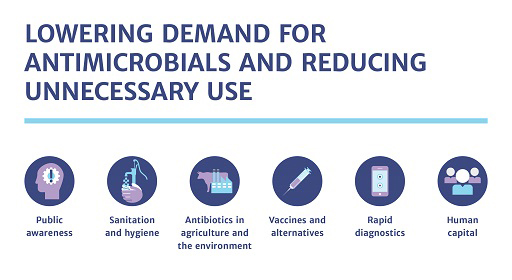1 Why do we need to reduce antibiotic use?
Antibiotics have revolutionised modern medicine and demand for them is high. However, as you saw in Week 5, there is a high correlation between the use of antibiotics and antibiotic resistance.
Antibiotic use is often unnecessary, so strategies to lower the demand for antibiotics or reduce their unnecessary use are crucial to tackling resistance. Several points in O’Neill’s ten-point plan contribute to lowering demand and reducing antibiotic use (Figure 2).
- Public awareness – increasing public awareness of when and how to take antibiotics correctly will reduce unnecessary use and lower demand.
- Sanitation and hygiene – reducing the spread of infectious diseases (including antibiotic-resistant ones) by improving sanitation and hygiene lowers the demand for antibiotics.
- Antibiotics in agriculture and the environment – reducing the unnecessary use of antibiotics in healthy animals to prevent infections in large-scale farming.
- Vaccines and alternatives – vaccines and alternatives to antibiotics that prevent and treat infections will lower the demand for antibiotics. You will learn more about this in Week 8.
- Rapid diagnostics – broad-spectrum antibiotics are often given before the infection is identified, just in case. Tools to rapidly diagnose infections will reduce the unnecessary prescribing of broad-spectrum antibiotics.
- Human capital – increasing the number of trained microbiologists and infection control specialists, while increasing awareness of antibiotic resistance among healthcare professionals, will reduce the unnecessary use of antibiotics by reducing infection rates and altering prescribing habits.
For the rest of this week you are going to look at two of these strategies – sanitation and hygiene, and rapid diagnostics.

